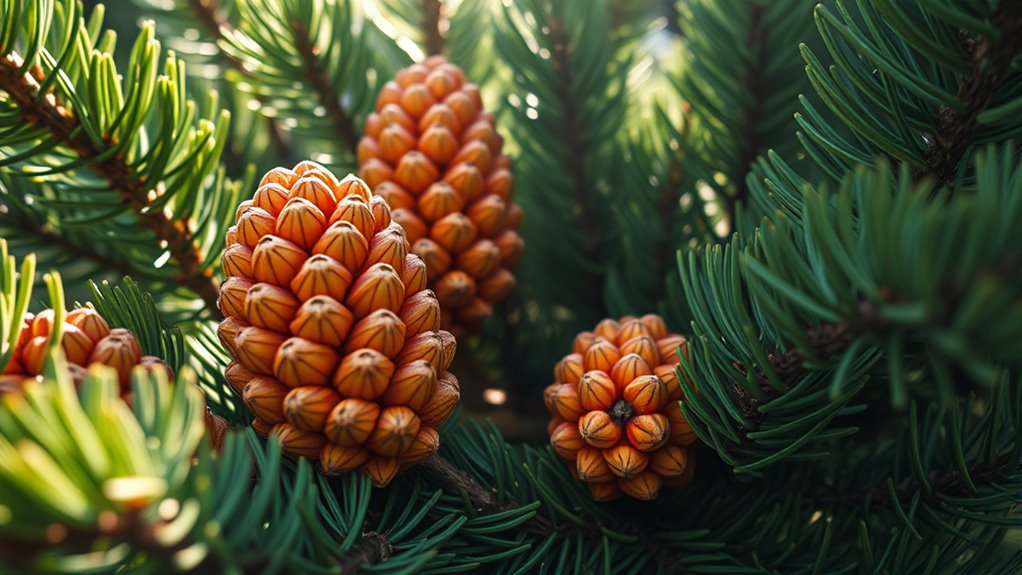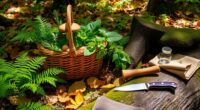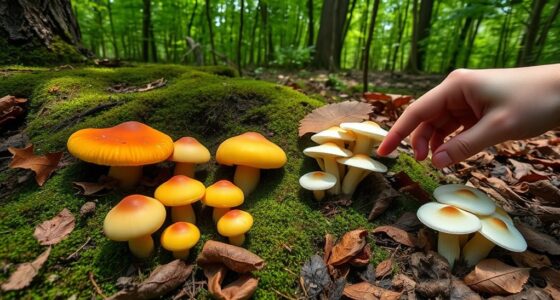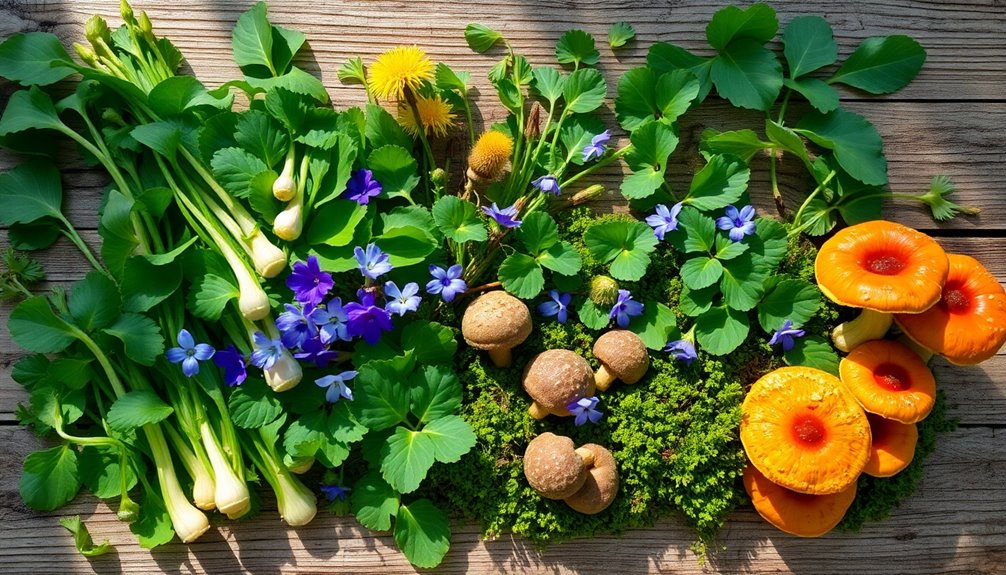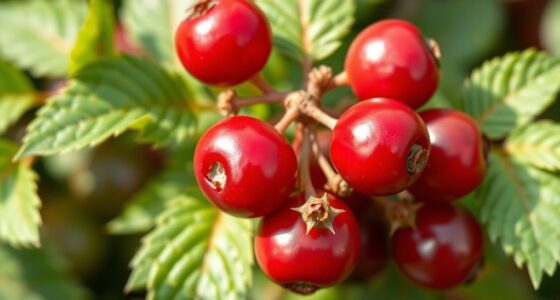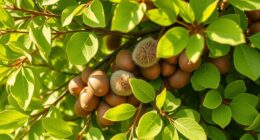Conifer trees hide a wealth of edible and medicinal parts that many overlook, like pine nuts, pine needles, and spruce tips. You can harvest pine nuts for a nutritious snack, brew flavorful teas from fresh needles, or incorporate conifer boughs into soups and desserts for added aroma and health benefits. Proper identification and harvesting are key to staying safe and making the most of these wild resources. Keep exploring to discover how to uncover these forgotten conifer edibles.
Key Takeaways
- Conifer needles, especially pine and spruce tips, are edible and rich in vitamin C, often overlooked in modern foraging.
- Pine nuts from mature cones are highly nutritious, yet their harvesting and culinary uses are underappreciated.
- Conifer boughs can be used to create medicinal infusions and flavorful culinary ingredients beyond traditional uses.
- Young conifer shoots and tips can be brewed into teas that boost immunity and mental clarity.
- Many conifer-based edibles and flavorings remain underused in contemporary cuisine, offering unique tastes and health benefits.
The Nutritional Power of Pine Nuts
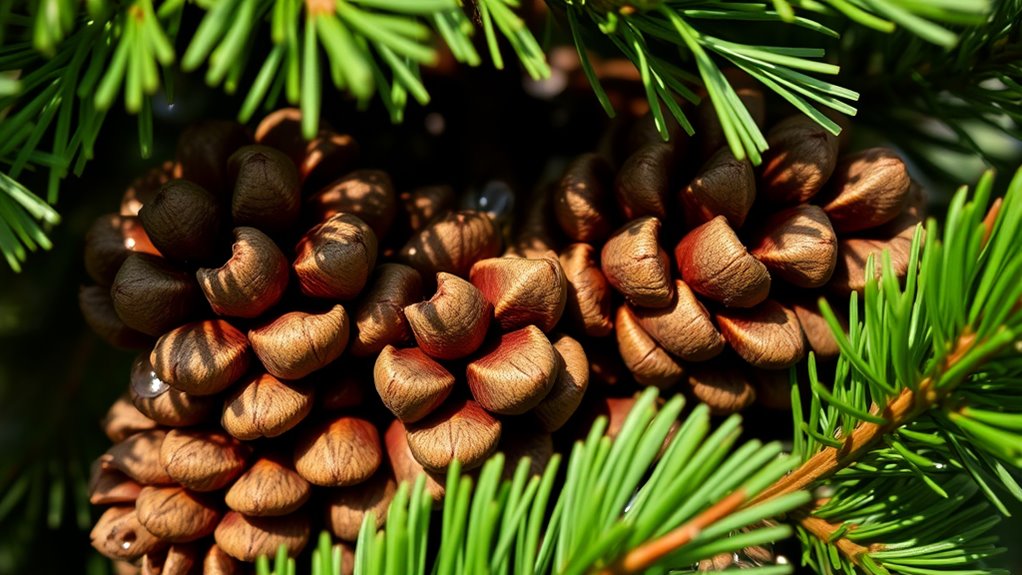
Pine nuts are often overlooked, but they pack a significant nutritional punch. These tiny seeds are rich in healthy fats, protein, vitamins, and minerals, offering impressive nutritional benefits. Incorporating pine nuts into your diet can boost energy levels and support overall health. To harvest them properly, you need to understand the harvesting techniques, which involve waiting for the pine cones to mature and then collecting them when they naturally open or using tools to extract the seeds. Proper harvesting guarantees you preserve the nuts’ freshness and nutritional value. Additionally, understanding the cost and budgeting involved in harvesting and processing pine nuts can help you plan effectively, especially if you are considering a DIY approach. By understanding these techniques, you can enjoy the full benefits of pine nuts, whether in salads, pesto, or snacks. Their nutritional benefits make them a valuable addition to a balanced diet, especially when harvested sustainably.
Brewing With Pine Needles and Spruce Tips
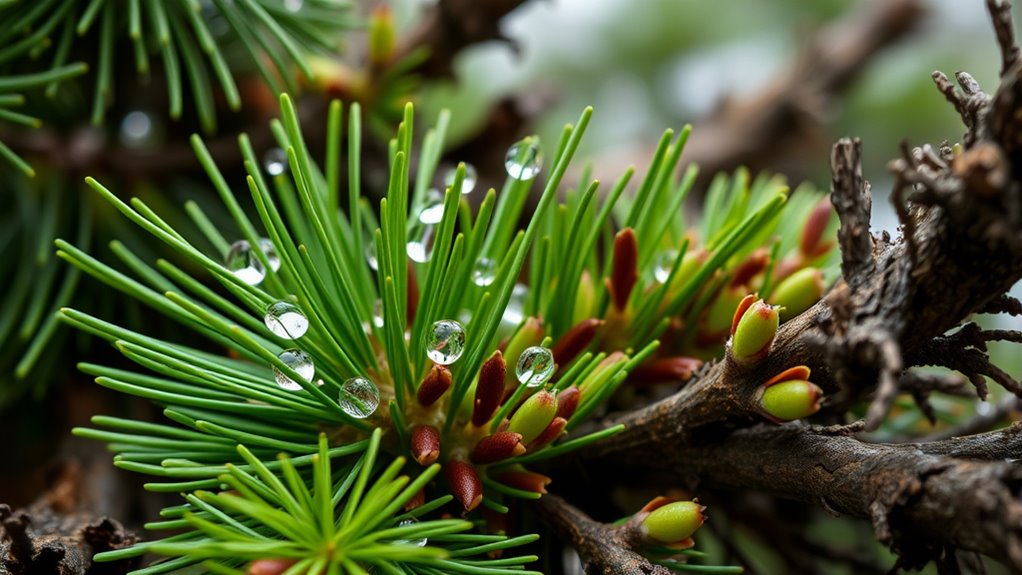
After learning how to harvest pine nuts, you might consider exploring other edible parts of conifer trees, like their needles and tips, to create flavorful herbal infusions. Brewing with pine needles and spruce tips is simple and invigorating. To make pine needle tea, gather fresh, young needles—avoid older, woody ones. Steep a handful in hot water for 10-15 minutes, releasing their vitamin C and aromatic oils. Be mindful of conifer resin, which is natural but can be bitter if overused. Spruce tips, harvested in spring, add a citrusy flavor and are perfect for infusions or syrups. These teas provide a revitalizing, healthful beverage that connects you with nature’s forgotten edibles, offering both flavor and wellness benefits straight from the forest. Incorporating these natural ingredients can also support cognitive function and memory retention, making your herbal infusions not only delicious but beneficial for your mental clarity.
Edible Conifer Boughs and Their Uses

While conifer boughs are often overlooked, they can be a valuable source of edible and flavorful ingredients when harvested properly. Many conifers possess notable medicinal properties, such as anti-inflammatory and respiratory benefits, making their boughs useful beyond flavoring. You can incorporate fresh or dried boughs into traditional conifer recipes, like herbal teas or broths, to boost health benefits and add natural aroma. When used correctly, these boughs provide a gentle, piney flavor that complements various dishes. Be sure to identify the right species and harvest with care, avoiding any that may be contaminated. Using conifer boughs not only enhances your culinary repertoire but also taps into their natural medicinal properties, making them a versatile addition to your edible wildcrafting toolkit.
Identifying and Harvesting Conifer Edibles Safely

Properly identifying and harvesting conifer edibles is essential to guarantee safety and maximize their benefits. In conifer forestry, many edible plant myths circulate, making accurate identification crucial. To avoid confusion, focus on key features like needle arrangement, cone structure, and bark texture. Always verify species with reliable guides or expert advice before harvesting. Remember, some look similar but aren’t edible, so mistaken identity can be dangerous. When collecting, use clean tools and avoid areas with pollution or pesticides. Keep in mind that misidentification can lead to health risks, so patience and proper research are vital. Consulting reliable identification resources can further reduce the risk of errors. Safe harvesting practices ensure you enjoy conifer edibles responsibly while respecting the environment. Taking these steps helps you confidently explore the lesser-known treasures in conifer forestry.
Culinary Ideas for Incorporating Conifer Flavors
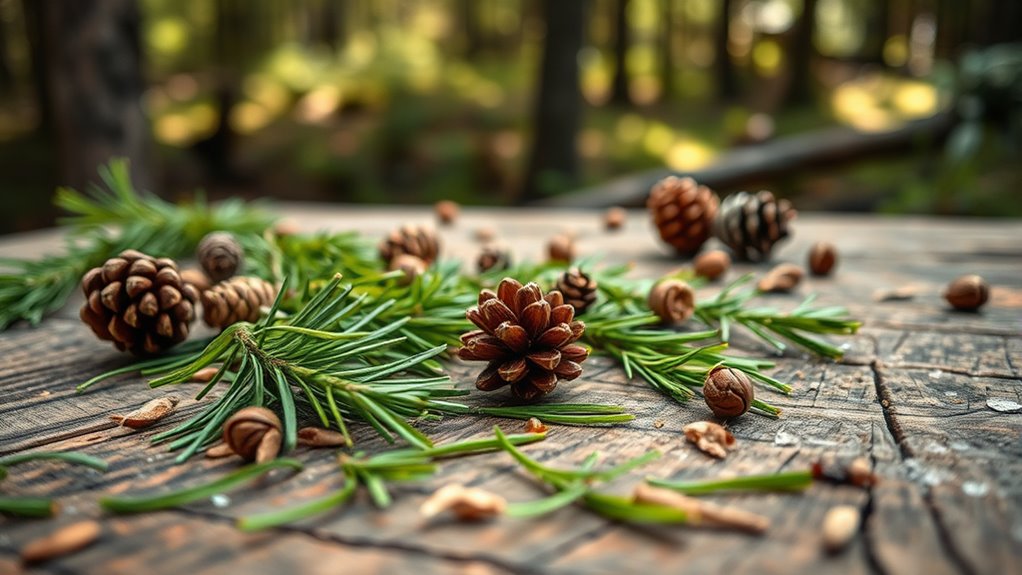
Conifer flavors bring a fresh, piney note to a variety of dishes, making them a versatile addition to your culinary repertoire. Exploring conifer flavor profiles allows you to enhance everything from soups to desserts with subtle, aromatic hints. Start with traditional conifer recipes like infused oils, syrups, or herb salts; these serve as a base for more creative dishes. Use pine or spruce needles to flavor roasted vegetables or meats, adding depth and complexity. You can also incorporate crushed conifer needles into teas or cocktails for a unique twist. Dried needles or tips can be ground into powders to season bread or crackers. Embracing these ideas helps you unbolt the full potential of conifers, transforming simple ingredients into memorable, flavorful creations.
Frequently Asked Questions
Are All Conifer Species Safe to Eat?
Not all conifer species are safe to eat. You need to be cautious because some species have toxicity risks, and proper edible identification is essential. Just because a tree is a conifer doesn’t mean its needles, bark, or seeds are edible. Always research specific species thoroughly before consuming any part of a conifer tree, and consult expert sources to avoid potential poisoning from toxic varieties.
How Can I Tell if a Conifer Edible Is Ripe?
To tell if a conifer edible is ripe, look for clear maturity indicators like color changes, which often mean it’s ready. You should also check the texture; it should feel firm but not hard. Avoid picking when the color is dull or if there’s any sign of mold or pests. Trust your senses—smell, sight, and touch—to guarantee it’s ripe and safe to harvest.
Do Conifer Edibles Have Any Allergenic Properties?
Ever wonder if conifer edibles might cause allergies? You should know that some people are sensitive to conifer pollen and resin allergies, which can trigger reactions when consuming parts of conifers. While many find these edibles safe, your best bet is to start with small amounts and observe how your body reacts. If you have existing allergies, consult a healthcare professional before trying conifer-based foods.
Can Conifer Leaves Be Used for Medicinal Purposes?
You can use conifer leaves for medicinal purposes because they possess notable conifer medicinal properties. Conifer leaf nutrition includes compounds like vitamin C, antioxidants, and essential oils that may boost your immune system and soothe respiratory issues. However, it’s important to identify the specific conifer species and consult with a healthcare professional before using them medicinally, as not all conifer leaves are safe or effective for this purpose.
What Are the Environmental Impacts of Harvesting Conifer Edibles?
When you harvest conifer edibles, you should prioritize sustainable harvesting to protect the environment. Overharvesting can disrupt ecological balance, harming wildlife and plant health. By harvesting responsibly, you ensure these resources remain available for future generations and support the overall ecosystem. This approach minimizes negative impacts and helps maintain the natural harmony of conifer forests, allowing you to enjoy their benefits without causing long-term environmental damage.
Conclusion
Now that you’ve uncovered the hidden treasures of conifer edibles, you’re armed with nature’s secret pantry. With a little knowledge, these overlooked gifts become your culinary compass, guiding you to flavors that are both wild and wonderful. Embrace the forest’s bounty like a seasoned explorer, turning what’s forgotten into a feast. The conifer’s edible treasures are waiting—just like a well-kept secret ready to bloom in your kitchen.

